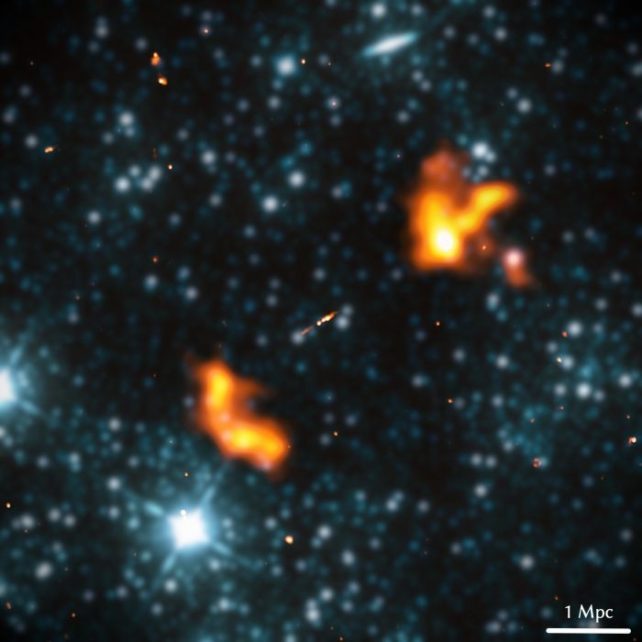The Biggest Galaxy Ever discovered by Astronomers,And The Scale Will Break Your Brain
Astronomers discovered a very enormous galaxy earlier this year.
Alcyoneus is a massive radio galaxy that is around 3 billion light-years away and extends 5 megaparsecs into space. With a length of 16.3 million light-years, it is the longest structure of known galactic origin.
The finding emphasizes how little we understand about these colossi and what fuels their phenomenal growth.
But it could open a door to a deeper comprehension of the intergalactic medium that floats in the vast gaps of space, not simply of massive radio galaxies.
Another enigma in a Universe full of them is giant radio galaxies. They are made up of a host galaxy, which is a collection of stars revolving around a supermassive black hole, as well as enormous jets and lobes that shoot out from the galaxy’s core.
By interacting with the intergalactic medium, these jets and lobes serve as a synchrotron, accelerating the radio-emitting electrons.
A supermassive black hole that is active and located in the galactic core is what scientists think is responsible for the jets. When a black hole is consuming material from a vast disk of stuff all around it, we regard to it as being “active.”
Not all of the matter in an active black hole’s accretion disk will eventually fall beyond of the event horizon. A tiny portion of it is somehow directed from the accretion disk’s interior to the poles, where it is blasted into space in the form of plasma jets at velocities close to the speed of light.
These jets are capable of covering vast distances before expanding into gigantic radio-emitting lobes.

This procedure is quite typical. The Milky Way has radio lobes as well. We don’t fully understand why some galaxies let them to expand to such enormous sizes, on megaparsec scales. The most severe examples of these so-called large radio galaxies may hold the key to understanding what propels their expansion.
The hosts of the largest giant radio galaxies “are likely to possess them, if there are host galaxy characteristics that are an important cause for giant radio galaxy growth,” the researchers wrote in their paper, which was released in April of this year. The research team was led by astronomer Martijn Oei of Leiden Observatory in the Netherlands.
Similar to this, the biggest gigantic radio galaxies are expected to be found in specific large-scale settings that are particularly favorable for their expansion.
The group searched for these anomalies in data gathered by the LOw Frequency ARray (LOFAR) across Europe, an interferometric network made up of over 20,000 radio antennas dispersed across 52 sites throughout Europe.
To remove compact radio emitters that could obstruct the identification of diffuse radio lobes and to adjust for optical distortion, they reprocessed the data using a new pipeline.
They claim that the obtained photos constitute the most sensitive search for radio galaxy lobes ever carried out. They then employed the greatest pattern-finding device at their disposal to find their target: their own eyes.
They discovered Alcyoneus in this fashion, erupting from a galaxy a few billion light-years away.
“We have found a massive radio galaxy with a projected proper length [of] 4.99 0.04 megaparsecs, which is the greatest known structure created by a single galaxy in terms of projection. At least 5.04 0.05 megaparsecs make up the true correct length “They spoke out.
Following the measurement of the lobes, the team utilized the Sloan Digital Sky Survey to examine the host galaxy.
The galaxy, which weighs around 240 billion times as much as the Sun and has a supermassive black hole at its heart that is about 400 million times as big as the Sun, was discovered to be a pretty typical elliptical galaxy buried in a filament of the cosmic web.
For massive radio galaxies, both of these characteristics are really at the low end, which may offer some insight into what promotes the development of radio lobes.
Beyond geometry, the researchers concluded that Alcyoneus and its host are “suspiciously ordinary” since their star masses, supermassive black hole masses, and overall low-frequency luminosity densities are all less than but comparable to those of the central big radio galaxies.
As a result, “huge giants are not required to grow in size, nor are high radio powers, assuming the observed condition is typical of the source across its lifespan.”
Alcyoneus may be expanding because it is located in an area of space with a lower density than the rest of space, or it may be expanding due to its interactions with the cosmic web.
Whatever is causing it, though, the scientists are confident that Alcyoneus is still expanding in the cosmic darkness, thousands of light-years distant.
The research was published in Astronomy & Astrophysics.
Do not forget to share your opinion with us to provide you with the best posts !



0 Comments